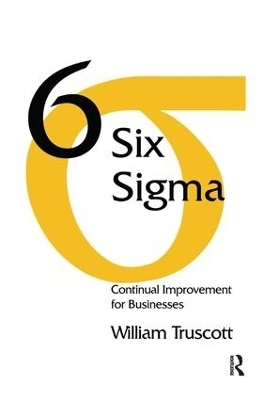
Six Sigma
Seiten
2017
Routledge (Verlag)
978-1-138-45556-6 (ISBN)
Routledge (Verlag)
978-1-138-45556-6 (ISBN)
Covers how to equip a critical mass of members in an organization with the core workforce competencies required to get the desired results. This book presents the realities of applying Six Sigma in a range of functions within an organization. It gives the foundations of good quality management and process control.
There are a number of distinctive features of this book that makes it different from other on Six Sigma. It recognizes that there are two diametrically opposing views expressed on Six Sigma, those that are strongly in favour, and those that are not, for various reasons. The book deals, head on, with the principle reasons for such hostility. It cuts through the hype associated with the brand name. It proposes simple remedies for certain defined frailties in the standard approach, particularly those related to the Sigma Measure that provides the brand name for the Six Sigma breakthrough strategy.The book is highly supportive of the Six Sigma continuous improvement process, provided it is tailored to the needs and expectations of a particular organization. The commitment and active participation of top management is emphasized, to ensure the necessary change in culture and priorities demanded, in most organizations. Practical guidance is given in the setting up, operating and developing the project by project approach across an organisation. The book also covers how to equip a critical mass of members in an organization with the core workforce competencies required to get the desired results.The book covers the realities of applying Six Sigma in a range of functions within an organization and also to various types of organizations from the manufacturing sector to commerce and public service. It demonstrates how statistical thinking, coupled with the application of technical and operational knowledge of processes and focus provided by Six Sigma, can considerably enhance quality, competitiveness, effectiveness and efficiency.Statistical process control is a tool, which enables both manufacturers and suppliers to achieve control of product quality by means of the application of statistical methods in the controlling process. This book
There are a number of distinctive features of this book that makes it different from other on Six Sigma. It recognizes that there are two diametrically opposing views expressed on Six Sigma, those that are strongly in favour, and those that are not, for various reasons. The book deals, head on, with the principle reasons for such hostility. It cuts through the hype associated with the brand name. It proposes simple remedies for certain defined frailties in the standard approach, particularly those related to the Sigma Measure that provides the brand name for the Six Sigma breakthrough strategy.The book is highly supportive of the Six Sigma continuous improvement process, provided it is tailored to the needs and expectations of a particular organization. The commitment and active participation of top management is emphasized, to ensure the necessary change in culture and priorities demanded, in most organizations. Practical guidance is given in the setting up, operating and developing the project by project approach across an organisation. The book also covers how to equip a critical mass of members in an organization with the core workforce competencies required to get the desired results.The book covers the realities of applying Six Sigma in a range of functions within an organization and also to various types of organizations from the manufacturing sector to commerce and public service. It demonstrates how statistical thinking, coupled with the application of technical and operational knowledge of processes and focus provided by Six Sigma, can considerably enhance quality, competitiveness, effectiveness and efficiency.Statistical process control is a tool, which enables both manufacturers and suppliers to achieve control of product quality by means of the application of statistical methods in the controlling process. This book
William T. Truscott
Chapter 1 What is Six Sigma?; Chapter 2 Why Should Organizations Implement Six Sigma?; Chapter 3 How does Six Sigma Compare with other Improvement Initiatives?; Chapter 4 How can Six Sigma Achieve the Greatest Impact on Business Performance?; Chapter 5 What Competencies are Required to Drive Six Sigma?; Chapter 6 What are the Options for Tailoring and Implementing Six Sigma?; Chapter 7 Is the Six Sigma Statistical Model Technically Sound?; Chapter 8 Which Sigma Should be Used?;
| Erscheinungsdatum | 07.08.2017 |
|---|---|
| Verlagsort | London |
| Sprache | englisch |
| Maße | 156 x 234 mm |
| Gewicht | 453 g |
| Themenwelt | Wirtschaft ► Betriebswirtschaft / Management ► Logistik / Produktion |
| Wirtschaft ► Volkswirtschaftslehre | |
| ISBN-10 | 1-138-45556-3 / 1138455563 |
| ISBN-13 | 978-1-138-45556-6 / 9781138455566 |
| Zustand | Neuware |
| Haben Sie eine Frage zum Produkt? |
Mehr entdecken
aus dem Bereich
aus dem Bereich
Grundlagen - Spezialthemen - Übungen
Buch | Softcover (2022)
Springer Gabler (Verlag)
CHF 55,95


